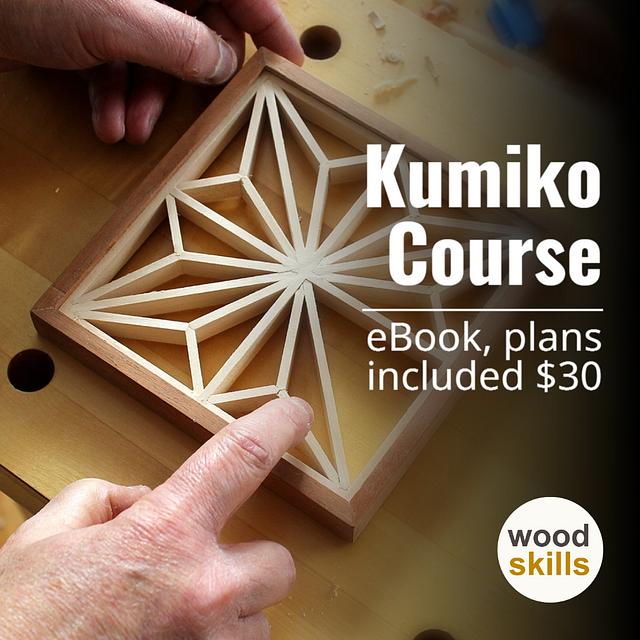Share your craft projects
Make new craft buddies
Ask craft questions
Blog your craft journey

Norman Pirollo
156 posts
and
18 followers
in over 5 years
in over 5 years
$30
14 videos
,8 pdf files
Project showcase
Secure checkout
Access anytime
Kumiko Course
14
video lessons

$30
14 videos
,8 pdf files
Project showcase
Secure checkout
Access anytime
Learn the traditional Japanese craft of Kumiko. The asa-no-ha motif is featured. Detailed steps to create the pattern are demonstrated and described. Guide Block plan included with course. Elevate your woodworking by incorporating Kumiko into furniture or wall art.
The Kumiko panels are created using several hand tools and some machinery in initial wood preparation. Follow me as I demonstrate the steps in creating a striking Kumiko panel you can incorporate in a piece of furniture, wall panel, or Shoji screen.
Topics covered in this 7 part Kumiko course:
- Intro and history of Kumiko
- Components of a Kumiko panel
- Wood preparation of Kumiko components
- Detailed video of Kumiko creation process
- Detailed steps to create guide blocks
- Techniques to simplify Kumiko making
- Incorporating a Kumiko panel in furniture
- Thicknessing sled
- Bench hook project
What’s included?
- 12 videos
- 9 files
START WOODWORKING (eBook)
Start woodworking today! This 115 pg. eBook provides an introduction to woodworking and the tools necessary to begin woodworking. Woodworking is a broad subject but the eBook explains the essentials. An inexpensive first set of tools is introduced and how to use them. Woodworking terminology is described along with important concepts to guide you through woodworking. A simple woodworking project is included. The project involves building a woodworking aid to use in future woodworking projects!
Kumiko Detail
A short glimpse of the Kumiko process of creating the beveled components for the grid. A Guide Block and chisel are used to perform this. Video has narration turned off as it only demonstrates detail of the Kumiko process.
Kumiko Article
Print article describing the Kumiko steps. Detailed steps and images provide a good understanding of the Kumiko creation process.
Kumiko Course
The traditional Japanese craft and technique of Kumiko is explored in this Kumiko Course. The course introduces the concept of Kumiko and its history. Kumiko has its origins in Japan and is used in homes and furniture. Video modules and lessons guide you through the creation of a Kumiko panel. The asa-no-ha pattern or motif is featured in the course, a common pattern. The course is composed of seven video segments, a Kumiko article from my recent book, and plans for (2) guide blocks. The guide blocks are an important tool in the creation of Kumiko panels. Each step in the process of creating a panel is covered from preparing a rough blank to final assembly. Many techniques and best practices are covered in the course.
The Kumiko panels in this course are created using several hand tools although some machinery is used in initial wood preparation. Hand tools consist of a wide chisel, a smoother plane and block plane. Follow me as I describe the steps involved in creating a striking Kumiko panel you can incorporate in a piece of furniture, wall panel, or Shoji screen.
Guide Blocks
This module includes videos that demonstrate how to create your own Kumiko Guide Blocks. The guide blocks are used to bevel the ends of components to fit the Kumiko square grid. The guide blocks are an important part of the Kumiko process and can be used indefinitely to create Kumiko components.
The Bench Hook
Introduction to the bench hook and how you can apply it in your work. Bench hooks excel at cutting small parts to size. Kumiko strips are easily sawn on a bench hook using a fine-toothed backsaw. One the Kumiko strips are thicknessed and ripped to a uniform width, the bench hook excels at cross-cutting the parts.
Thicknessing Sled
The thicknessing sled is an easy to make jig that attaches to the workbench surface. Sliding a block plane along rabbeted grooves enables you to accurately thickness small narrow boards. The thicknessing sled is often used to reduce Kumiko strips down to a uniform size, but can be used for other components such as jewelry box dividers.
HAND TOOL WOODWORKING (eBook, 130 pgs.)
Incorporate hand tools in your woodworking! This 130 pg. eBook provides an introduction to hand tools necessary for woodworking and furniture making. Critical hand tools and their application is presented. Hand tools are a proven option to using machines in woodworking. Although machines remove the initial drudgery of preparing wood, hand tools can be used in the following stages of a furniture build. Hand tools eliminate the dust and noise associated with woodworking. A more pleasant, less stressful environment results. Discover which hand tools to invest in for your woodworking.
Norman has authored several books (New Art Press) and featured in publications.
- Quiet Woodworking: In An Unquiet World (New Art Press)
- Hand Tool Woodworking (New Art Press)
- Start Woodworking (New Art Press)
- Craftisian Interview (Norman Pirollo)
- HackSpace Magazine – Make With Wood April 2020
- Woodworking: From Design To Making (New Art Press)
- Woodworking With Hand Tools 2018 (Fine Woodworking)
- The Wood Artist: Creating Art Through Wood (New Art Press)
- From Hi-Tech to Lo-Tech: A Woodworker’s Journey (New Art Press)
- Start Your Own Woodworking Business (New Art Press)
- Rooted: Contemporary Studio Furniture (Schiffer Publishing)
- Canadian Woodworking Mag. Jan. 2015
- Our Homes magazine Fall 2014
- NICHE Magazine Winter 2013
- FWW Magazine – 4 Bench Jigs for Handplanes
- FWW Magazine – Essential Shopmade Jigs
- Woodwork magazine (2008)
- Wood Art Today 2 (Schiffer Books)
- 500 Cabinets ( Lark Books)
- Studio Furniture: Today’s Leading Woodworkers
- Canadian Interiors Design Source Guide
- Ottawa Life magazine (Profile, work) 2012
- Panoram Italia magazine
- Our Homes magazine (2011)
- Craft Journal (2009)
- Woodworker’s Journal (2006)
-
Lesson 1Kumiko Course 1
-
Lesson 2Kumiko Course 2
-
Lesson 3Kumiko Course 3
-
Lesson 4Kumiko Course 4
-
Lesson 5Guide Block 1
-
Lesson 6Guide Block 2
-
Lesson 7Guide Block 3
-
Lesson 8Bench Hook 1
-
Lesson 9Bench Hook 2
-
Lesson 10Bench Hook 3
-
Lesson 11Thicknessing Sled
-
Lesson 12Kumiko Close Up
-
Lesson 13Start Woodworking (eBook)
-
Lesson 14Hand Tool Woodworking (eBook, 130 pgs.)








